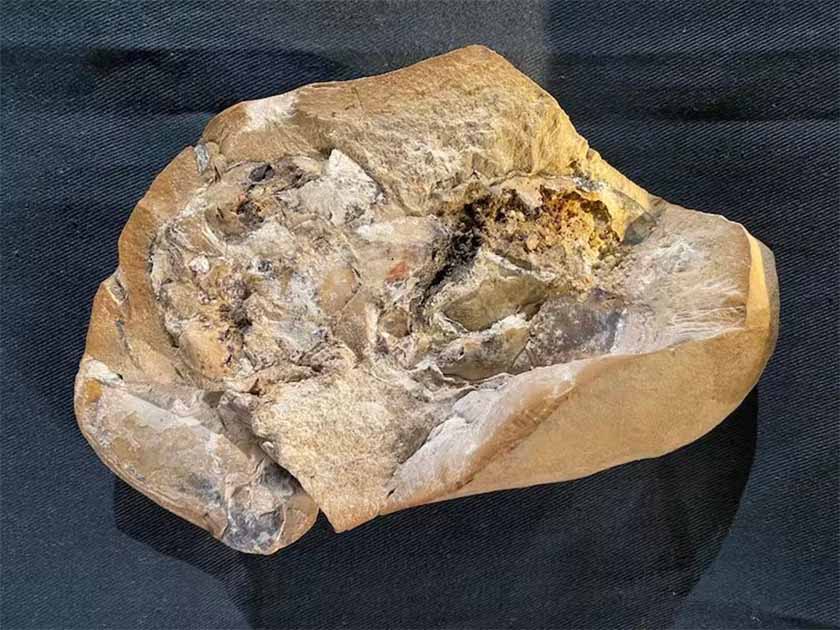
“A mind-boggling, jaw-dropping” 380-million-year-old fossilized heart has been discovered in Western Australia, preserved inside a now extinct prehistoric fish known as the Gogo. The Gogo Station fossil site located near Kimberley has unique minerals that have acted to “preserve” the fish’s fossilized heart, the oldest heart ever found so far.
This is exceptionally rare in the world of fossils as it is usually bones that become fossils not internal organs. The Gogo fossilized heart discovery has provided a crucial window into understanding the process of evolution, showing the early evolution of body plans. The presence of the backbone on this jawed fish represents an evolutionary step towards a body plan not found in most animals with a backbone today including human beings!

Professor Kate Trinajstic of Curtin University inspects the ancient fossil containing the 380-million-year-old fossilized heart at the Western Australian Museum. Source: Curtin University
Gogo Fish Placoderms: Fossilized Hearts, Jaws, and Backbones
The fossilized heart of the Gogo fish was the subject of a detailed and comprehensive team study published in Science, led by Professor Kate Trinajstic, paleontologist and evolutionary biologist at Curtin University, Western Australia. “Evolution is often thought of as a series of small steps, but these ancient fossils suggest there was a larger leap between jawless and jawed vertebrates. These fish literally have their hearts in their mouths and under their gills – just like sharks today,” she said.
She’s referring to the preservation of two-chambered organs, which are preserved within the amazing 3-D fossils of ancient armored fish called placoderms. Placoderms were the first vertebrates to develop jaws, around 400 million years ago.
Placoderm fish, like the Gogo, were the dominant life form on Earth for 60 million years, existing in the seas a full 100 million years before the first dinosaurs walked across the land. Placoderms were the first fish with jaws and teeth, and the first to exceed 30 centimeters (11.8 inches) in length. These much larger fish could be as long as 9 meters (29.5 feet).
The Gogo fish and its fossilized heart proves that the heart was separated from other internal organs already 380 million years ago.
“Evolution is often thought of as a series of small steps, but these ancient fossils suggest there was a larger leap between jawless and jawed vertebrates. These fish literally have their hearts in their mouths and under their gills – just like sharks today,” said Professor Trinajstic.
When examined with a modern scanning device the Gogo fish’s fossilized heart proved to have two chambers on top of each other, similar to the human heart, reported the BBC. This arrangement was a critical step that made the heart more efficient, transforming the slow-moving fish to a rapid moving predator. Professor Long described them as “a voracious predator.”
“What’s really exceptional about the Gogo fishes is that their soft tissues are preserved in three dimensions. Most cases of soft-tissue preservation are found in flattened fossils, where the soft anatomy is little more than a stain on the rock,” said co-author Professor Per Ahlberg, from Uppsala University.

The 3D, preserved Gogo placoderm fish, bones are shown in grey, and the fish’s fossilized heart in red. (Kate Trinajstic / Curtin University)
Modern Scanning Techniques and Paleontology
Professor Ahlberg further explained that without modern scanning techniques, the tissues could not be studied without destroying them. The work the team did on the Gogo fish fossil would have been impossible ten years ago. They enlisted the help of scientists from the Australian Nuclear Science and Technology Organization and the European Synchrotron Radiation Facility in France.
At Gogo Station’s Fitzroy Crossing, fish fossils were found in the 1940s. It was in the 1960s that beautiful 3D preservations were revealed, with a technique whereby fossilized bones could be removed from the rock with weak acetic acid. Then in 2010, with the advent of an X-ray method called synchrotron microtomography, the fossil could be examined in great detail without damaging it at all.
The scans of the Gogo fish’s heart revealed intricate details including atriums, ventricles, and an outflow tract. The liver was large and allowed for enhanced buoyancy similar to modern day sharks. Today’s bony fish like lungfish and birchers have lungs for buoyancy, lungs that evolved from swim bladders.
“These new discoveries of soft organs in these ancient fishes are truly the stuff of paleontologists’ dreams, for without doubt these fossils are the best preserved in the world for this age. They show the value of the Gogo fossils for understanding the big steps in our distant evolution. Gogo has given us world firsts, from the origins of sex to the oldest vertebrate heart, and is now one of the most significant fossil sites in the world. It’s time the site was seriously considered for world heritage status,” concluded paleontologist John Long of Flinders University, Australia.
With the latest study, Kimberly has been established as one of the most important fossil sites worldwide for revealing key evolutionary evidence related to changes in early body plans.